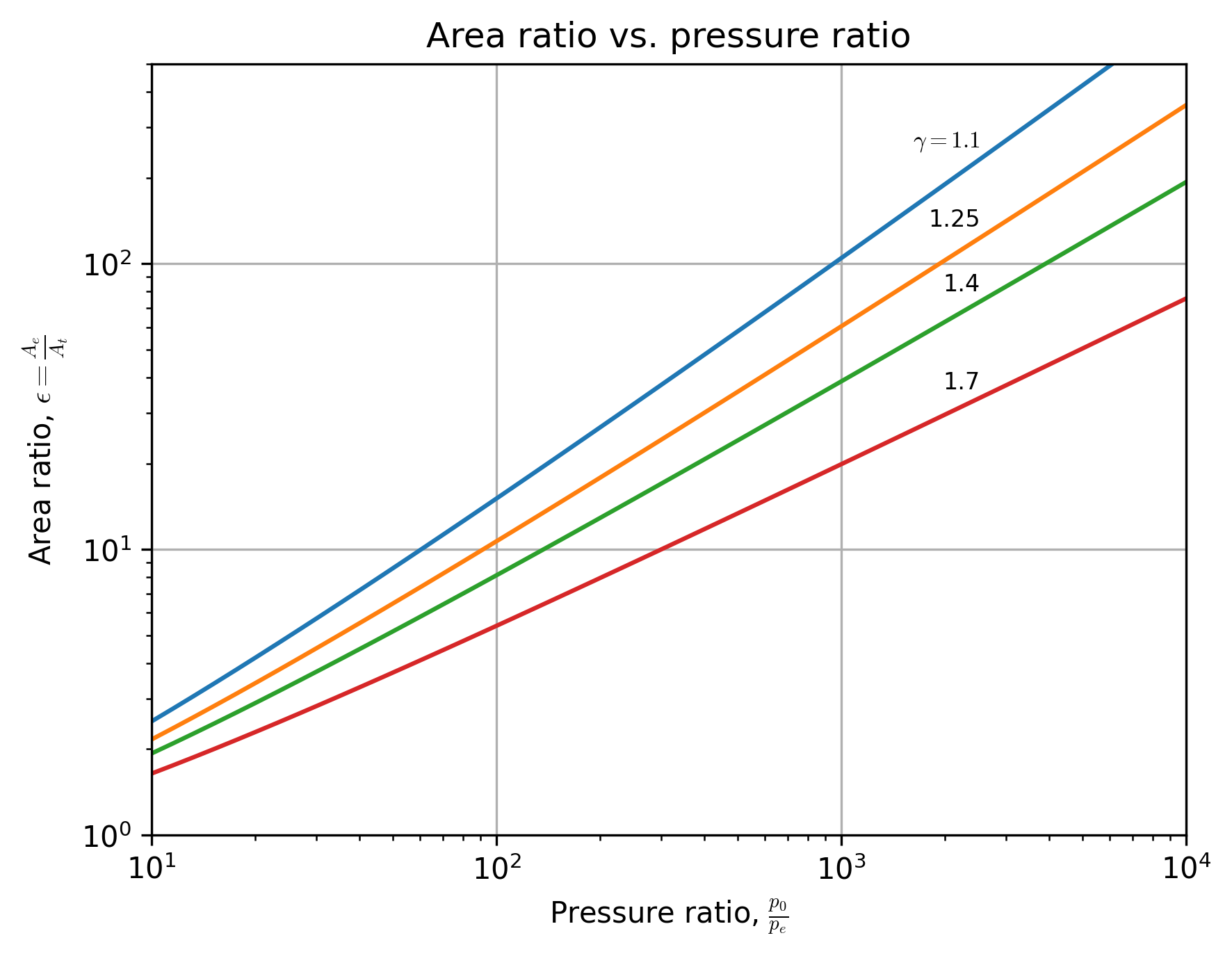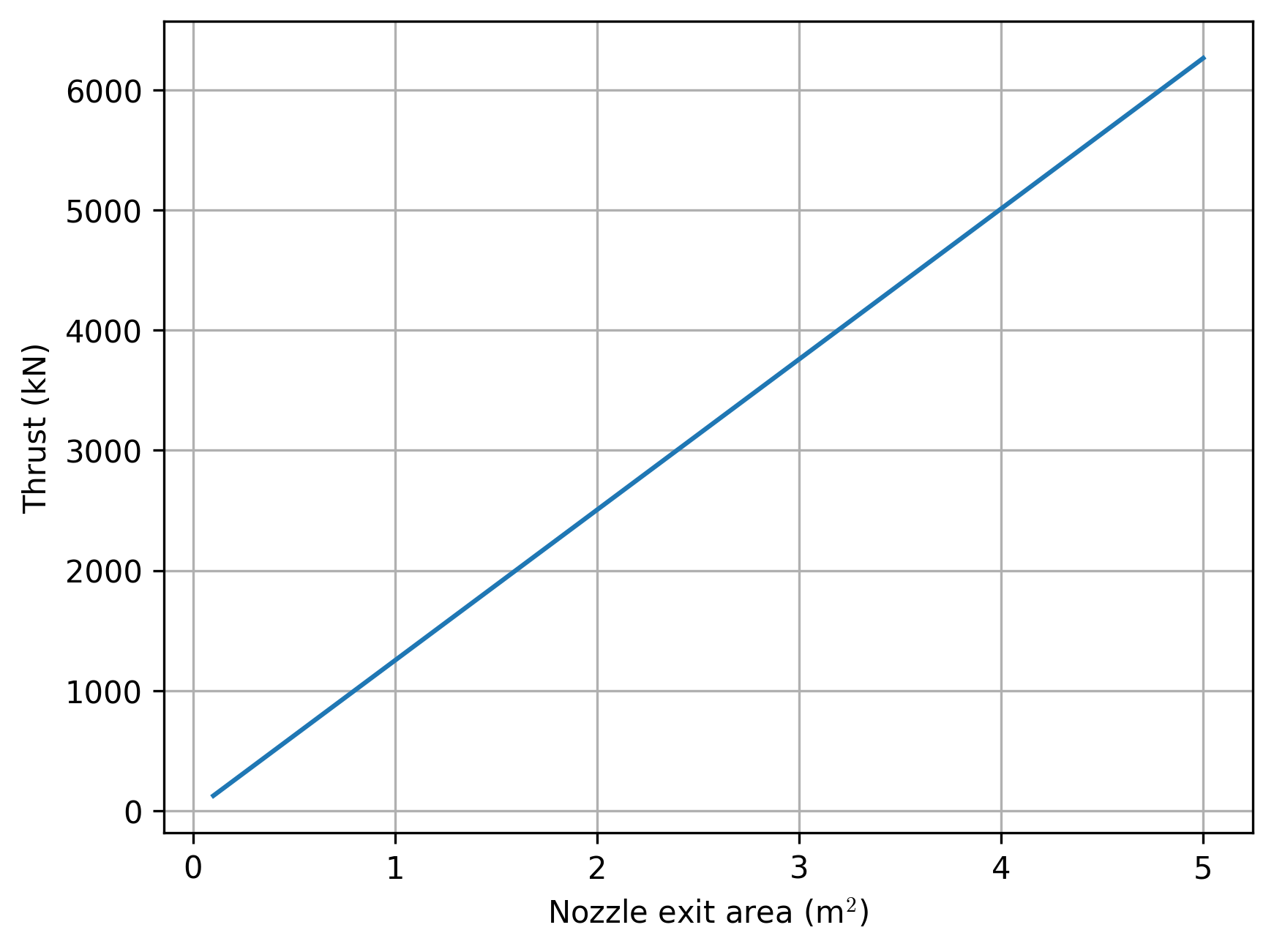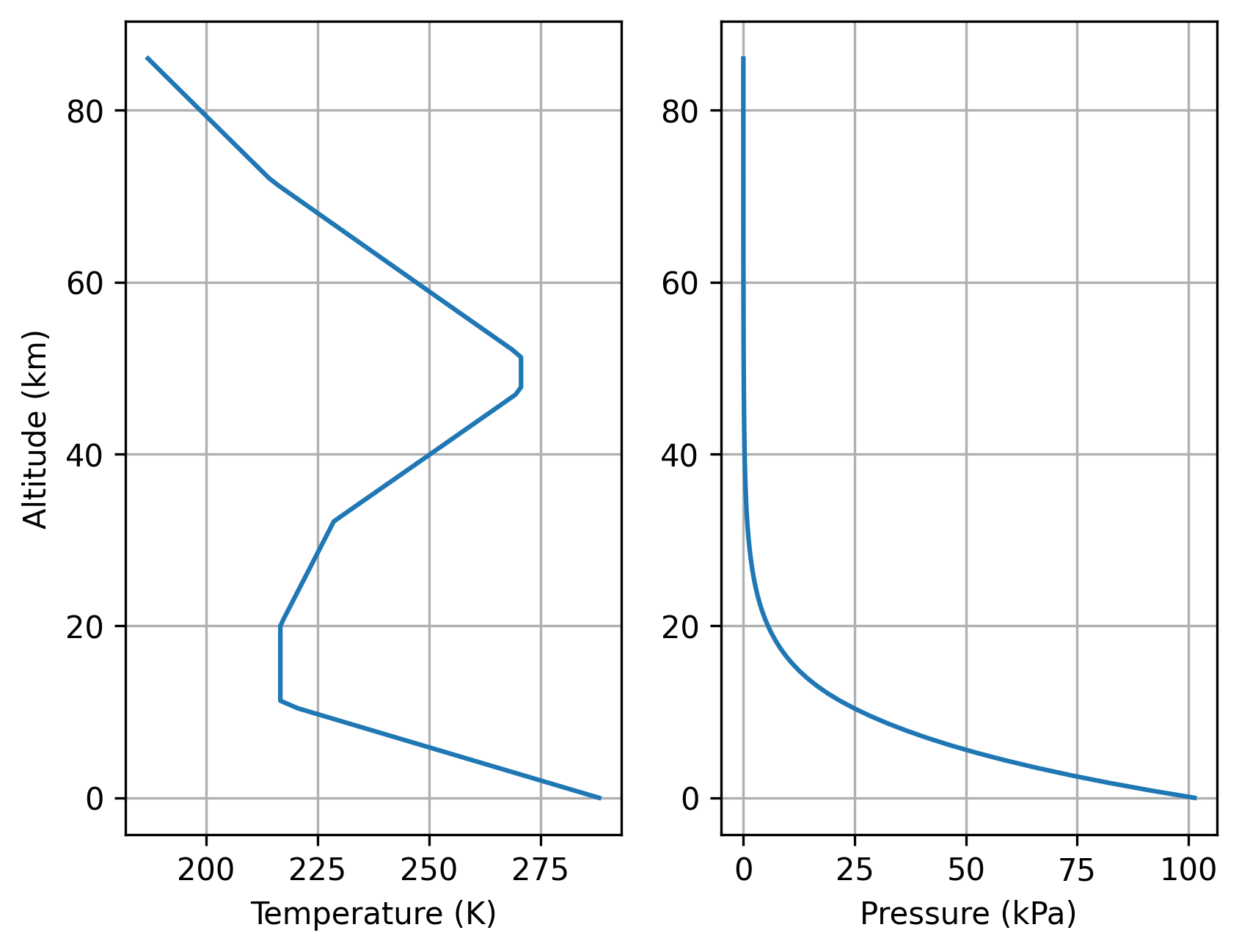Ideal rocket analysis#
# this line makes figures interactive in Jupyter notebooks
%matplotlib inline
from matplotlib import pyplot as plt
import numpy as np
# we can use this to solve nonlinear/transcendental equations
from scipy.optimize import root_scalar
# this provides access to many physical constants
from scipy import constants
# provides the 1976 US Standard Atmosphere model
from fluids.atmosphere import ATMOSPHERE_1976
# Module used to parse and work with units
from pint import UnitRegistry
ureg = UnitRegistry()
Q_ = ureg.Quantity
# for convenience:
def to_si(quant):
'''Converts a Pint Quantity to magnitude at base SI units.
'''
return quant.to_base_units().magnitude
Show code cell source
# these lines are only for helping improve the display
import matplotlib_inline.backend_inline
matplotlib_inline.backend_inline.set_matplotlib_formats('pdf', 'png')
plt.rcParams['figure.dpi']= 300
plt.rcParams['savefig.dpi'] = 300
plt.rcParams['mathtext.fontset'] = 'cm'
Characteristic velocity: c*#
where \(p_0\) and \(T_0\) are the combustion chamber pressure and temperature, \(R\) is the specific gas constant (\(\mathcal{R}_u / MW\)), and \(\gamma\) is the specific heat ratio.
Thrust coefficient#
where \(T\) is thrust, \(p_e\) is the nozzle exit pressure, \(A_e\) and \(A_t\) are the nozzle exit and throat areas, and \(p_a\) is the ambient pressure.
Relationships with thrust, specific impulse, and effective exhaust velocity#
Using characteristic velocity (\(c^*\)) and thrust coefficient (\(C_F\)), we can express thrust, specific impulse (\(I_{\text{sp}}\)), and effective exhause velocity (\(c\)):
Area ratio#
The nozzle area ratio (exit area to throat area) can be determined directly from the nozzle pressure ratio:
where \(\frac{p_0}{p_e}\) is the pressure ratio (chamber pressure to nozzle exit pressure).
Designing rocket nozzles#
Rocket scientists (… rocket engineers) have used the above equations for thrust coefficient, area ratio, and Mach number to design rockets for many years.
For example, the following figures show area ratio vs. pressure ratio, and thrust coefficient (at optimum expansion conditions, where \(p_e = p_a\)) vs. pressure ratio, both for various specific heat ratios:
## area ratio as a function of pressure ratio
gammas = [1.1, 1.25, 1.4, 1.7]
pressure_ratios = np.logspace(1, 4, num=50)
labels = [r'$\gamma = 1.1$', '1.25', '1.4', '1.7']
# let's define a function to calculate area ratio based on gamma and the pressure ratio:
def calc_area_ratio(gamma, pressure_ratio):
'''Calculates area ratio based on specific heat ratio and pressure ratio.
pressure ratio: chamber / exit
area ratio: exit / throat
'''
return (
np.power(2 / (gamma + 1), 1/(gamma-1)) *
np.power(pressure_ratio, 1 / gamma) *
np.sqrt((gamma - 1) / (gamma + 1) /
(1 - np.power(pressure_ratio, (1 - gamma)/gamma))
)
)
for gamma, label in zip(gammas, labels):
area_ratios = calc_area_ratio(gamma, pressure_ratios)
plt.plot(pressure_ratios, area_ratios)
plt.text(
0.9*pressure_ratios[-10], 1.01*area_ratios[-10],
label,
horizontalalignment='right', fontsize=8
)
plt.xlim([10, 1e4])
plt.ylim([1, 500])
plt.xlabel(r'Pressure ratio, $\frac{p_0}{p_e}$')
plt.ylabel(r'Area ratio, $\epsilon = \frac{A_e}{A_t}$')
plt.grid(True)
plt.xscale('log')
plt.yscale('log')
plt.title('Area ratio vs. pressure ratio')
plt.show()

# Define a function to calculate thrust coefficient, assuming optimum expansion
# (exit pressure = ambient pressure), based on gamma and pressure ratio:
def calc_thrust_coeff(gamma, pressure_ratio):
''' Calculates thrust coefficient for optimum expansion.
pressure ratio: chamber / exit
area ratio: exit / throat
'''
return np.sqrt(
2 * np.power(gamma, 2) / (gamma - 1) *
np.power(2 / (gamma + 1), (gamma + 1)/(gamma - 1)) *
(1 - np.power(1.0 / pressure_ratio, (gamma - 1)/gamma))
)
# This function returns zero for a given area ratio, pressure ratio, and gamma,
#and is used to numerically calculate pressure ratio given the other two values.
def root_area_ratio(pressure_ratio, gamma, area_ratio):
''' pressure ratio: chamber / exit
area ratio: exit / throat
'''
return area_ratio - calc_area_ratio(gamma, pressure_ratio)
gammas = [1.1, 1.2, 1.3, 1.4]
labels = [r'$\gamma = 1.1$', '1.2', '1.3', '1.4']
area_ratios = [3, 5, 10, 20, 50, 100]
pressure_ratios = np.logspace(1, 4, num=50)
for gamma, label in zip(gammas, labels):
thrust_coeffs = calc_thrust_coeff(gamma, pressure_ratios)
plt.plot(pressure_ratios, thrust_coeffs)
plt.text(
0.9*pressure_ratios[-1], 1.01*thrust_coeffs[-1],
label, horizontalalignment='right'
)
for area_ratio in area_ratios:
pressure_ratios2 = np.zeros(len(gammas))
thrust_coeffs2 = np.zeros(len(gammas))
for idx, gamma in enumerate(gammas):
sol = root_scalar(root_area_ratio, x0=20, x1=100, args=(gamma, area_ratio))
pressure_ratios2[idx] = sol.root
thrust_coeffs2[idx] = calc_thrust_coeff(gamma, sol.root)
plt.plot(pressure_ratios2, thrust_coeffs2, '--')
plt.text(
pressure_ratios2[-1], thrust_coeffs2[-1],
r'$\epsilon =$' + f'{area_ratio}',
horizontalalignment='left', verticalalignment='top', fontsize=8
)
plt.xlim([10, 1e4])
plt.ylim([1.2, 2.3])
plt.xlabel(r'Pressure ratio, $p_0/p_e$')
plt.ylabel(r'Thrust coefficient, $C_F$')
plt.grid(True)
plt.xscale('log')
plt.title('Thrust coefficient vs. pressure ratio, at optimum expansion')
plt.show()

Example: using equations to design optimal rocket nozzle#
Using the above equations, design a rocket nozzle optimally for these conditions: \(p_c\) = 70 atm, \(p_e\) = 1 atm, and \(\gamma\) = 1.2. Find the nozzle area ratio, and the rocket thrust as a function of nozzle exit area.
We know the pressure ratio:
so we can directly calculate the nozzle area ratio:
# set the given constants
chamber_pressure = Q_(70, 'atm')
exit_pressure = Q_(1, 'atm')
gamma = 1.2
pressure_ratio = chamber_pressure / exit_pressure
area_ratio = (
np.power(2 / (gamma + 1), 1/(gamma-1)) *
np.power(pressure_ratio, 1 / gamma) *
np.sqrt((gamma - 1) / (gamma + 1) /
(1 - np.power(pressure_ratio, (1 - gamma)/gamma))
)
)
print(f'Nozzle area ratio: {area_ratio: 3.2f~P}')
Nozzle area ratio: 9.06
Since \(p_e = p_a\) by design (for an optimal nozzle), we can calculate the thrust coefficient using:
and then thrust using:
thrust_coeff = np.sqrt(
2 * np.power(gamma, 2) / (gamma - 1) *
np.power(2 / (gamma + 1), (gamma + 1)/(gamma - 1)) *
(1 - np.power(1.0 / pressure_ratio, (gamma - 1)/gamma))
)
print(f'Thrust coefficient = {thrust_coeff: 3.2f~P}')
thrust_per_area = thrust_coeff * chamber_pressure / area_ratio
print(f'Thrust = ({thrust_per_area.to("kPa"): 5.1f~P} * A_e)')
Thrust coefficient = 1.60
Thrust = ( 1252.5 kPa * A_e)
We can now examine the thrust for a range of exit areas:
exit_areas = Q_(np.linspace(0.1, 5, num=50), 'm^2')
plt.plot(exit_areas.to('m^2').magnitude, (thrust_per_area * exit_areas).to('kN').magnitude)
plt.xlabel('Nozzle exit area ' + r'(m$^2$)')
plt.ylabel('Thrust (kN)')
plt.grid(True)
plt.show()

Example for design of a rocket#
# given constants
altitude = Q_(10000, 'm')
c_star = Q_(1500, 'm/s')
gamma = 1.2
MW = Q_(25, 'kg/kmol')
chamber_pressure = Q_(70, 'bar')
thrust_10k = Q_(100000, 'N')
burn_time = Q_(5, 's')
First, we need to calculate the nozzle pressure ratio, which requires obtaining the pressure at the rocket’s flight altitude.
The 1976 U.S. Standard Atmosphere [NOAANASAaUSAF76] is a model for how pressure, temperature, density, etc., vary with altitude in the atmosphere, and provides reasonable answers for up to about 86 km.
The fluids package provides a convenient interface to this model in Python [Bel20],
along with other models such as the NRLMSISE-00 model [PHDA02], which applies up to 1000 km.
Let’s look at how temperature and pressure vary with altitude, using this model:
altitudes = np.linspace(0, 86000, num=100)
temperatures = np.zeros(len(altitudes))
pressures = np.zeros(len(altitudes))
for idx, h in enumerate(altitudes):
atm = ATMOSPHERE_1976(h)
temperatures[idx] = atm.T
pressures[idx] = atm.P
fig, axes = plt.subplots(1, 2)
axes[0].plot(temperatures, altitudes/1000)
axes[0].set_xlabel('Temperature (K)')
axes[0].set_ylabel('Altitude (km)')
axes[0].grid(True)
axes[1].plot(pressures/1000, altitudes/1000)
axes[1].set_xlabel('Pressure (kPa)')
axes[1].grid(True)
plt.show()

We can use this to obtain the pressure at the flight altitude, and calculate pressure ratio:
# use model for 1976 US Standard Atmosphere to get pressure at altitude
ten_km = ATMOSPHERE_1976(to_si(altitude))
exit_pressure = Q_(ten_km.P, 'Pa')
print(f'Pressure at {altitude.to("km")}: {exit_pressure: .0f}')
pressure_ratio = chamber_pressure / exit_pressure
print(f'Pressure ratio (p_c/p_e): {pressure_ratio.to_base_units(): .1f}')
Pressure at 10.0 kilometer: 26500 pascal
Pressure ratio (p_c/p_e): 264.2 dimensionless
Next, we can calculate the nozzle area ratio and thrust coefficient (for optimum expansion, since \(p_e = p_a\)):
which are defined in Equations (4) and (5) above—and we have already written functions to evaluate them!.
area_ratio = calc_area_ratio(gamma, pressure_ratio)
print(f'Area ratio: {area_ratio.to_base_units(): .2f~P}')
thrust_coeff = calc_thrust_coeff(gamma, pressure_ratio)
print(f'Thrust coefficient: {thrust_coeff.to_base_units(): .2f~P}')
Area ratio: 25.10
Thrust coefficient: 1.75
throat_area = thrust_10k / (thrust_coeff * chamber_pressure)
print(f'Throat area: {throat_area.to("m^2"): .4f~P}')
throat_diameter = 2 * np.sqrt(throat_area / np.pi)
print(f'Throat diameter: {throat_diameter.to("m"): .3f~P}')
Throat area: 0.0082 m²
Throat diameter: 0.102 m
exit_area = area_ratio * throat_area
print(f'Exit area: {exit_area.to("m^2"): .2e~P}')
exit_diameter = 2 * np.sqrt(exit_area / np.pi)
print(f'Exit diameter: {exit_diameter.to("m"): .3f~P}')
Exit area: 2.05e-01 m²
Exit diameter: 0.511 m
mass_flow_rate = chamber_pressure * throat_area / c_star
print(f'Mass flow rate: {mass_flow_rate.to("kg/s"): .2f~P}')
Mass flow rate: 38.14 kg/s
specific_impulse = c_star * thrust_coeff / Q_(constants.g, 'm/s^2')
print(f'Specific impulse: {specific_impulse.to("s"): .1f~P}')
Specific impulse: 267.3 s
propellant_mass = mass_flow_rate * burn_time
print(f'Propellant mass: {propellant_mass.to("kg"): .1f~P}')
Propellant mass: 190.7 kg
# constant.R is given in J/(K mol), need J/(K kmol)
chamber_temperature = (
c_star**2 * gamma * (MW / Q_(constants.R, 'J/(K*mol)')) *
np.power(2 / (gamma+1), (gamma+1)/(gamma-1))
)
print(f'Chamber temperature: {chamber_temperature.to("K"): .1f~P}')
Chamber temperature: 2845.4 K
# Thrust at sea level
thrust_coeff_sea_level = thrust_coeff + area_ratio * (
1/pressure_ratio - Q_(1, 'atm')/chamber_pressure
)
thrust_sea_level = thrust_coeff_sea_level * chamber_pressure * throat_area
print(f'Thrust at sea level: {thrust_sea_level.to("kN"): .1f~P}')
Thrust at sea level: 84.7 kN

